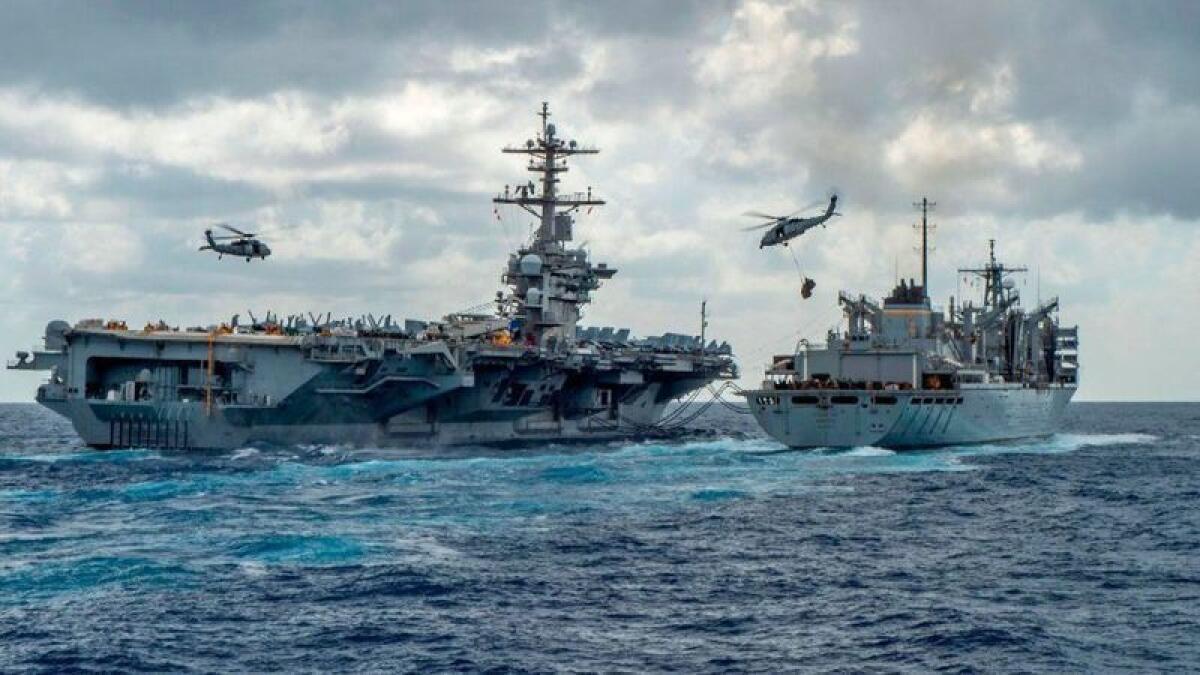Citing Iran threat, U.S. to send up to 1,500 more troops to Middle East

- Share via
Reporting from Washington — The Pentagon said Friday it was sending as many as 1,500 more troops to the Middle East in response to what officials described as a campaign of low-level attacks directed by Iran on U.S. allies in the Middle East.
President Trump said the forces, which include a fighter squadron, manned and unmanned reconnaissance aircraft, engineering units and additional Patriot anti-missile batteries, were “relatively small” and would have a “mostly protective” role aimed at deterring Iran.
“Right now, I don’t think Iran wants to fight, and I certainly don’t think they want to fight with us,” Trump told reporters at the White House before leaving on a trip to Japan.
The reinforcements are the latest escalation in a tense series of military moves by Washington and Tehran that have increased tensions in the Persian Gulf and raised the danger of a military clash.
At the Pentagon, officials sharpened claims that Iran had incited the crisis, asserting without providing evidence that recent attacks on four oil tankers and a Saudi pipeline, and a rocket attack in Baghdad, were ordered by Iran’s top leaders and carried out by its forces or proxies.
“We believe with a high degree of confidence that this stems back to the leadership of Iran at the highest levels,” Vice Adm. Michael Gilday, the head of the Pentagon’s Joint Staff, said at a news conference announcing the deployments.
He said that U.S. intelligence agencies “attribute” sabotage attacks that damaged four oil tankers off the coast of the United Arab Emirates this month to Iran’s Islamic Revolutionary Guard Corps using “limpet mines,” a naval munition attached to a target by magnets.
Gilday’s comments were the first time a senior U.S. official had publicly blamed Iran for the tanker attacks.
But he declined to describe what evidence the U.S. had linking Iran to the attack or that which backed up the U.S. claim that Iran’s top leaders had been planning and preparing for other attacks.
“I can’t reveal the sources, other than to say we have very high confidence,” he said when pressed by reporters to describe the evidence.
Former military officers warned that the absence of communication channels between Washington and Tehran, and the mixed signals coming from the Trump administration, heighten the potential danger of armed conflict.
If there is a “shooting incident,” retired U.S. Navy Vice Admiral John Miller said, “there is no commander-to-commander way to discuss the incident, to deescalate the incident.” Until his retirement in 2015, Miller served as commander of naval forces in U.S. Central Command, which operates in the Persian Gulf.
Miller spoke Friday at a forum on Iran at the Washington Institute for Near East Policy.
The additional forces, which will begin arriving in coming weeks, were sought by Gen. Kenneth F. McKenzie Jr., the top commander of U.S. forces in the Middle East, only weeks after the Pentagon ordered the Abraham Lincoln carrier strike force, four B-52 bombers and a Patriot anti-missile battalion to the region.
That was in response to what officials said was intelligence showing Iran had put cruise missiles aboard small boats. The U.S. has not released satellite photographs backing up that claim.
Gilday and acting Assistant Secretary of Defense Katie Wheelbarger, who joined the news conference, said U.S. officials warned Iran through diplomatic channels against carrying out any attacks, while stressing that the U.S. was not seeking a military confrontation.
“We are seeking to avoid hostilities, and we are not seeking war with Iran,” said Wheelbarger. “We have been as clear as we possibly can in that regard.”
McKenzie sought additional forces after intelligence suggested Iran was still keeping forces at high alert.
Acting Defense Secretary Patrick Shanahan said in a statement that he had approved the request after briefing Trump on Thursday “to improve our force protection and safeguard U.S. forces given the ongoing threat posed by Iranian forces, including the [Revolutionary Guard] and its proxies.”
The engineers would “provide force protection improvements throughout the region,” while the fighter squadron would “provide additional deterrence and depth to our aviation response options.”
McKenzie is especially interested in the Patriot batteries to help defend against potential Iranian missile attacks on U.S. troops, facilities and allies in the region, officials said.
But he played down the scale of the U.S. deployment, saying the actual number of new troops going to the Middle East was closer to 900 than 1,500. That’s because the Patriot batteries approved by the Pentagon have been in the region until recently, and the latest order merely extends their deployment.
Times staff writer Tracy Wilkinson contributed to this report.
Pentagon asks Trump to send several thousand more troops to Mideast as Iran tensions grow »
More to Read
Get the L.A. Times Politics newsletter
Deeply reported insights into legislation, politics and policy from Sacramento, Washington and beyond. In your inbox three times per week.
You may occasionally receive promotional content from the Los Angeles Times.











